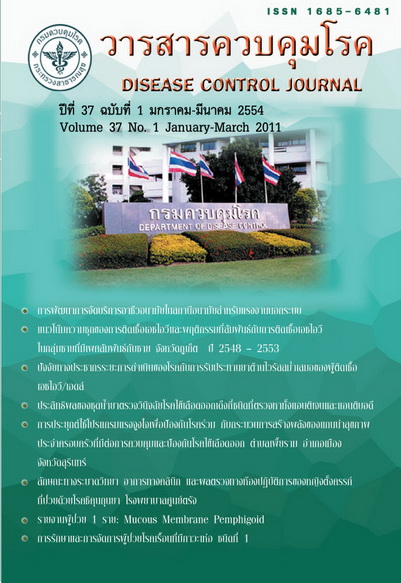Demographic Factors, Stage of Disease and Adherence of Antiretroviral Drug Therapy in HIV/AIDS
Keywords:
Demographic Factors, Stage of Disease, Adherence of Antiretroviral, HIV/AIDSAbstract
This study was retrospective study. 3,622 Samples of HIV/AIDS patients were 18 years old and over and first visit at 3 hospitals in Thailand, 2007. Data were collected from patient histories in the special database program. This study examines the relationship between demographic factors, stage of disease and adherence among patients receiving HAART. Adherence was used self-report questions and add together to get total score equal 16. Data analysis was used Multiple Logistic Regression. Multivariate analysis found that only hospital, age at HIV infected, gender, marital status, education, and stage of disease are statistically significant. The odds of adherence patients adhering to the HAART of the patient fromat San Pa Tong hospital and Lop Buri hospital were greater 33.9 and 6.3 times greater compared to patients at Bamrasnaradura Infectious Diseases Institute, respectively. The odds of adherence patients aged 25-34, 35-44, and 45 years old and over adhering to antiretroviral drug were greater compared to patients aged 18-24 years old. The odds of adherence female patients' adherence were greater 1.19 times compared to male patients. The odds of adherence for the married patients were greater 1.2 times compared to single patients. The odds of adherence no education patients with no education were greater compared to higher education patients. Patients with symptomatic and AIDS are less likely to have adherence than compare to asymptomatic patients. The outcome of this study suggested that adherence among patients receiving HAART should concern about was related to demographic factors and stage symptomatic of disease. We should emphasize on knowledge, attitude, practice, mental support and continuous treatment among symptomatic and AIDS patients.
Downloads
References
2. Paterson D, Swindells S, Mohr J, Brester M, Vergis EN, et al. Adherence to protease inhibitor therapy and outcomes in patients with HIV infection. Ann Intern Med 2000; 133:21-30.
3. http://www.kaewdiary.com/webboard/show.php?CatelD=&No=33436. ทำไม Adherence จึงมีความสำคัญมากต่อการใช้ยาต้านไวรัสเอดส์. Available online; Wed 04 Jul 2550.
4. สำนักการพยาบาล กรมการแพทย์ กระทรวงสาธารณสุข. การดูแลรักษาผู้ติดเชื้อเอชไอวี และผู้ป่วยโรคเอดส์. โรงพิมพ์องค์การรับส่งสินค้าและพัสดุภัณฑ์. กรุงเทพมหานคร. 2546.
5. King W D, Minor P, Ramirez Kitchen C, Or? LE, Shoptaw S, Victorianne G D, Rust G. Racial, gender and geographic disparities of antiretroviral treatment among US medical enroles in 1998. J Epidemiol Community Health 2008; 62:798-803.
6. เยาวเรศ ดีคง. ปัจจัยของผู้ดูแลที่มีผลต่อการรับประทานยาอย่างสม่ำเสมอของผู้ป่วยที่รับประทานยาต้านไวรัสเอดส์. วิทยานิพนธ์วิทยาศาสตร์มหาบัณฑิต. มหาวิทยาลัยมหิดล. 2547.
7. สมจิตร์ ตุลาทอง. ปัจจัยที่มีผลต่อการรับประทานยาอย่างสม่ำเสมอ ของผู้ป่วยที่รับประทานยาต้านไวรัสเอดส์. วิทยานิพนธ์วิทยาศาสตร์มหาบัณฑิต. มหาวิทยาลัยมหิดล. 2547.
8. Wang X, Wu Z. Factors associated with adherence to antiretroviral therapy among HIV/AIDS patients in rural China. AIDS 2007; Suppl 8:S149-55.
9. อภินันท์ จิรจริต. การศึกษาการติดตามการรับประทานยาต้านเชื้อไวรัสในผู้ป่วยเด็กที่ติดเชื้อไวรัสเอชไอวีของโรงพยาบาลภูมิพลอดุลยเดช. ราชวิทยาลัยกุมารแพทย์แห่งประเทศไทย. http://www.thaipediatrics.org/detail_journal.php?
journal_id=127. Available online; 09/02/2553.
10. Arrivillaga M, Ross M, Useche B, Alzate ML,Correa D. Social position, gender role, and treatment adherence among Colombian women living with HIV/AIDS: social determinants of health approach. Rev Panam Salud Publica 2009; 26(6): 502-10.
11. Mannheimer SB, Mukherjee R, Hirschhorn LR, Dougherty S, Celano sa, Ciccarone D, et al. The case adherence index: A novel method for measuring adherence to antiretroviral therapy. AID CARE 2006; 18(7): 853-61.
12. Nsimba S, Irunde H, Comoro C. Barriers to ARV adherence among HIV/AIDS positive persons taking anti-retroviral therapy in two Tanzanian regions 8-12 months after program initiation. http://www.omicsonline.org/2155-6113/2155-6113-1-111.php. Available online; doi:10.4172/2155-6113.1000111.
13. Ahianba JE, Dimuna KO, Okogun RA. Built environment decay and urban health in Nigeria. J. Hum. Ecol 2008; 23(3): 259-65.
14. Nunes AA, de Melo IM, da Silva AL, Rezende L dos S, Guimaraes PB, Silva-Vergara ML. Hospitalizations for HIV/AIDS: differences between sexes. Gend Med 2010; 7(1):28-38.
15. Jani AA. Ed. Adherence to HIV treatment regimens: Recommendations for best practices. Washington, DC: American Public Health Association 2002.
Downloads
Published
How to Cite
Issue
Section
License
Articles published in the Disease Control Journal are considered as academic work, research or analysis of the personal opinion of the authors, not the opinion of the Thailand Department of Disease Control or editorial team. The authors must be responsible for their articles.






